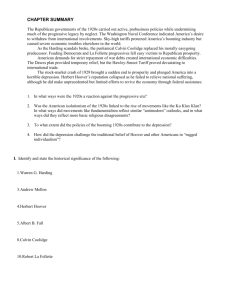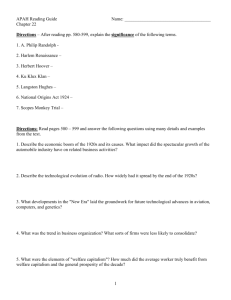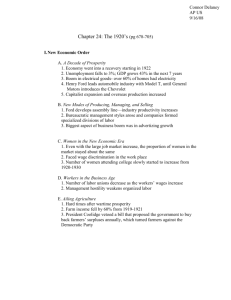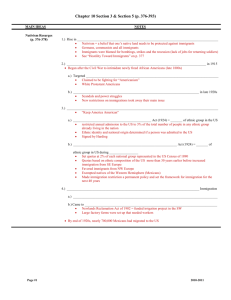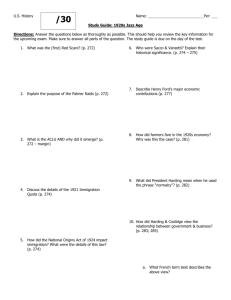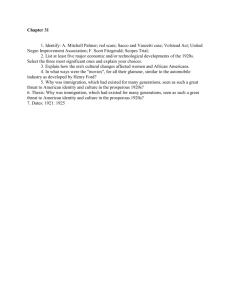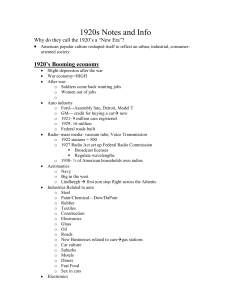The 1920s: Economic & Social Change in America
advertisement
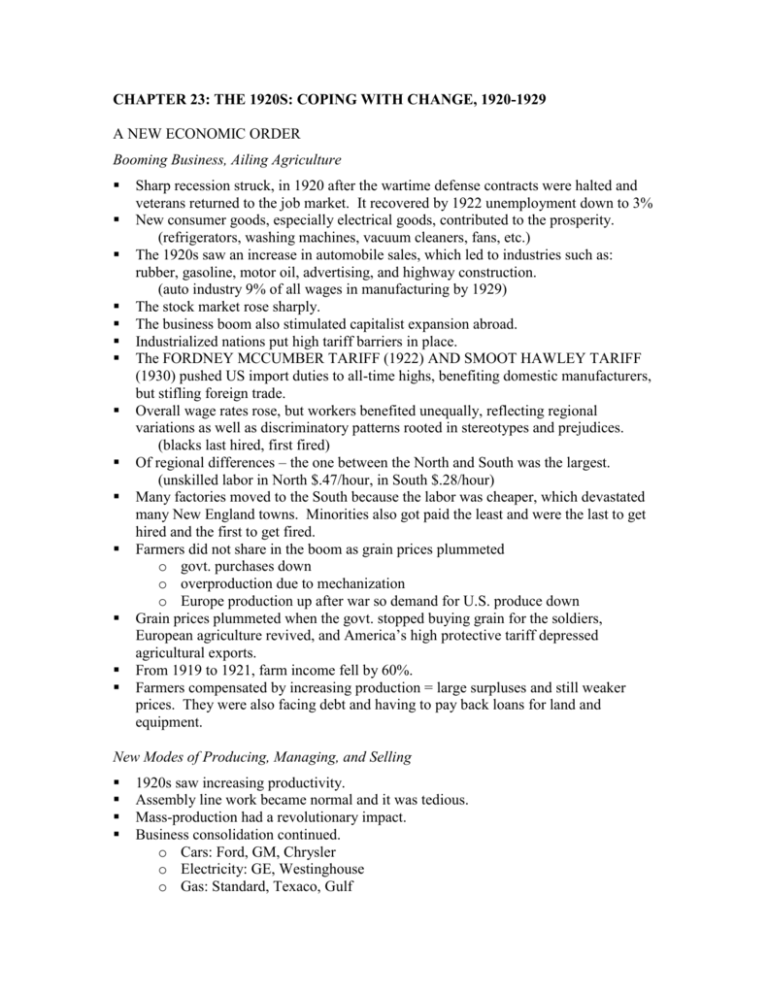
CHAPTER 23: THE 1920S: COPING WITH CHANGE, 1920-1929 A NEW ECONOMIC ORDER Booming Business, Ailing Agriculture Sharp recession struck, in 1920 after the wartime defense contracts were halted and veterans returned to the job market. It recovered by 1922 unemployment down to 3% New consumer goods, especially electrical goods, contributed to the prosperity. (refrigerators, washing machines, vacuum cleaners, fans, etc.) The 1920s saw an increase in automobile sales, which led to industries such as: rubber, gasoline, motor oil, advertising, and highway construction. (auto industry 9% of all wages in manufacturing by 1929) The stock market rose sharply. The business boom also stimulated capitalist expansion abroad. Industrialized nations put high tariff barriers in place. The FORDNEY MCCUMBER TARIFF (1922) AND SMOOT HAWLEY TARIFF (1930) pushed US import duties to all-time highs, benefiting domestic manufacturers, but stifling foreign trade. Overall wage rates rose, but workers benefited unequally, reflecting regional variations as well as discriminatory patterns rooted in stereotypes and prejudices. (blacks last hired, first fired) Of regional differences – the one between the North and South was the largest. (unskilled labor in North $.47/hour, in South $.28/hour) Many factories moved to the South because the labor was cheaper, which devastated many New England towns. Minorities also got paid the least and were the last to get hired and the first to get fired. Farmers did not share in the boom as grain prices plummeted o govt. purchases down o overproduction due to mechanization o Europe production up after war so demand for U.S. produce down Grain prices plummeted when the govt. stopped buying grain for the soldiers, European agriculture revived, and America’s high protective tariff depressed agricultural exports. From 1919 to 1921, farm income fell by 60%. Farmers compensated by increasing production = large surpluses and still weaker prices. They were also facing debt and having to pay back loans for land and equipment. New Modes of Producing, Managing, and Selling 1920s saw increasing productivity. Assembly line work became normal and it was tedious. Mass-production had a revolutionary impact. Business consolidation continued. o Cars: Ford, GM, Chrysler o Electricity: GE, Westinghouse o Gas: Standard, Texaco, Gulf As US capitalism matured, more elaborate management structures arose. They set up separate divisions for product development, market research, economic forecasting, employee relations, and so forth. Some business leaders concluded that higher wages would improve productivity and increase consumer-buying power. Ford led the way paying his workers $5/day. Chain stores and department stores were popular. (A.& P. grocery stores) Advertising became huge. ($2 billion spent in 1929 – radio, billboards, newspapers, magazines) They had celebrity endorsements. Buying on credit became popular – installment plans with fixed payment schedules. They usually reserved credit for big-ticket items. Women in the New Economic Era About 24% of the female population worked in the 1920’s, about the same as before. Mechanization and assembly line (w/ less physical labor required) did not improve women’s opportunities in factories like it should have They faced wage discrimination. They began to find work in offices as secretaries, typists, or filing clerks. (due to telephone and typewriter) They kept men in managerial positions and women in clerical positions. Women physicians declined from 1910 to 1930 because of quotas established. More women graduated high school and went on to college – 12% by 1920 Struggling Labor Unions in a Business Age Union membership declined because: o despite regional variations overall wage rates climbed steadily, reducing the incentives to join o older craft-based unions were ill suited to new mass-production factories o management hostility weakened organized labor, thugs were hired to intimidate union organizers. Others set up employee associations and provided cafeterias and recreational facilities for workers. Some sold company stocks for low prices. This was called “welfare capitalism”; it was probably used to ward off unions. “Open shop” – non-union shops Black membership remained low and most unions were discriminatory even though they said they weren’t. (as with the A.F.L.) Many blacks acted as “scabs” because it was the only work that they could get. Scabs worked when union members went on strike. THE HARDING AND COOLIDGE ADMINISTRATIONS Stand Pat Politics in a Decade of Change In the 1920s, Republicans pulled from northern farmers, corporate leaders, businesspeople, native-born white-collar workers and professionals, and some skilled blue-collar workers. The Democrats’ base remained the white south and the immigrant cities. The 1920 Republican convention nominated Warren G. Harding. The Democrats nominated James Cox. Harding won – he had notable cabinet members and sleazy corrupt ones. o Notable ones: Charles Evans Hughes (Sec. of State), Andrew Mellon (Sec. of Treasury, Herbert Hoover (Sec. of Commerce) o the sleazy ones – set the tone for the corrupt Harding presidency o cabinet (particularly corrupt ones) known as the Ohio Gang, as it was made up of mostly members from Harding’s home state Aug. 2, 1923 Harding died of a heart attack (avoiding being the target of blame for scandals) In 1924 a Senate investigation pushed by Democratic senator Thomas J. Walsh of Montana exposed the full scope of the scandals. TEAPOT DOME SCANDAL – Interior Secretary, Albert Fall, went to jail for leasing government oil reserves, one in Teapot Dome, Wyoming, to 2 oilmen in return for a $400,000 bribe. Vice President Calvin Coolidge became president after Harding’s death. o Shy, respectable person who was very popular with conservatives, at a time when there was great social change Republican Policymaking in a Pro-business Era The moral tone improved, but the pro-business climate persisted, symbolized by high tariffs, lowered income taxes and inheritance taxes for the rich “TRICKLE DOWN THEORY” – it held that tax cuts for the wealthy would promote business investment, stimulate the economy, and thus benefit everyone. Treasury Secretary, Andrew Mellon embraced this theory though he rejected calls to end the income tax as it might give socialists an issue to draw support from While eager to promote corporate interests, Coolidge opposed government assistance for other groups. He was challenged in 1927 when huge rainfall flooded the Mississippi River. Coolidge refused to send aid or visit the devastated areas. He did reluctantly sign the FLOOD CONTROL ACT OF 1928 – and appropriate $325 million for a 10-year program to construct levees along the Mississippi.) Hard-pressed farmers rallied behind the MCNARY-HAUGEN BILL – s price support plan under which the government would annually purchase the surplus of six basic farm commodities – cotton, rice, corn, hogs, tobacco, and wheat – at their average price in 1909-1914 (when farm prices were high). The government would then sell these surpluses abroad at prevailing prices and make up any resulting losses through a tax on domestic sales of these commodities. This bill passed Congress twice and Coolidge vetoed it both times. This led many farmers to abandon the Republican Party and vote Democratic in 1928. Independent Internationalism INDEPENDENT INTERNATIONALISM – After the war, the US pursued global policies that they believed to be in America’s national interest. In spite of the isolationist tendencies (as seen in its refusal to join League of Nations or its World Court). They tried to control arms after the war at the WASHINGTON NAVAL ARMS CONFERENCE. They agreed along with GB, France, Japan, and Italy to reduce their naval battleship tonnage. (to promote world peace and reduce govt. spending) KELLOGG-BRIAND PACT – renouncing aggression and calling for the outlawing of war. (1928). It lacked an enforcement mechanism and did little to prevent WWII. US, France and 60 other nations signed this. The US wanted to be repaid for WWI With US foreign investments expanding, the government worked to advance American business interests abroad. Progressive Stirrings, Democratic Party Divisions The reform spirit survived feebly in the legislative branch. In 1922, a midterm election year, labor and farm groups formed the Conference for Progressive Political Action (CPPA), which helped defeat some conservative Republicans. In 1924 they revived Lafollette for President. The Democrats, split between urban (mostly Catholic immigrants) and rural (mostly Southern Protestants) wings. They couldn’t decide on a nominee and chose an obscure John W. Davis. Coolidge wan the Republican nomination. The platform rested on the FORDNEY-MCCUMBER TARIFF and urged tax and spending cuts. Coolidge won by a landslide. Progressive Stirrings, Democratic Party Divisions The 19th Amendment had little political affect; many women scattered across the political spectrum or withdrew from politics altogether. As the women’s movement splintered, it lost focus. o younger women saw the older generation of feminists as out of touch, and were concerned with the consumption and materialism of the 1920s) o Jane Addams and other women’s rights leaders faced accusations of communist sympathies. Alice Paul’s National Woman’s Party proposed equal rights amendment for women The Supreme Court struck down child-labor laws in 1922 and women’s protective laws in 1923. A 1924 child-labor constitutional amendment passed Congress after heavy lobbying by women’s organizations, but few states ratified it. MASS SOCIETY, MASS CULTURE Cities, Cars, and Consumer Goods For the first time, in the 1920 census there were more urban (more that 2,500 people) than rural places. Many African Americans flocked to cities, especially after the Mississippi River flood. For women, city life meant electric and gas appliances that reduced household labor. Food preparation and diet shifted in response to urbanization and technological changes. The availability of canned fruit and vegetables got rid of canning for many. Food became available year round because of refrigeration. Store bought clothes replaced home-made apparel The automobile had a huge social impact. o The car gave people greater mobility, but it also eroded family cohesion and parental authority. It allowed kids to borrow the car and get away. o Tractors became popular on farms – with this the rural debt crisis worsened. o It allowed for supermarkets, department stores, and fast food chains to take off. o With availability of buses, one room school houses became thing of the past. o The automobile was too expensive for many – it was mainly for the prosperous. o Family vacations by car possible (increasing tourism and related businesses like restaurants) o Car lessened rural isolation. Soaring Energy Consumption and a Threatened Environment Because of the innovation the US sucked up coal, oil, and natural gas. National parks were now open to more tourists because of the automobile. This helped because it created a larger constituency for environmental awareness. Yet, it made more demand for rest stops, hotels, etc. Secretary of Commerce Herbert Hoover created a NATIONAL CONFERENCE ON OUTDOOR RECREATION – to set national recreation policies and try to balance the Progressive Era conservationist ethic and the vacation-minded leisure culture of the 1920s. The Sierra Club and Audubon Society worked to protect wilderness and wildlife. Mass-Produced Entertainment Mass-circulation magazines (Saturday Evening Post, Reader’s Digest) Radio (1st station KDKA in Pittsburgh in 1921, 500 stations by 1922) Movies (companies like MGM, Warner Brothers, Columbia; stars like Charlie Chaplin, Rudolph Valentino) NBC and CBS were created for radio companies 1927 sound was introduced to the movies This was all a byproduct of urbanization and the culture changes that followed. Radio & movies spread mass culture and created a somewhat more unified national identity. It penetrated the country unevenly; it was less popular in rural areas and strong resistance among evangelical Christians suspicious of modernity. The theaters provided opportunities for conversation, socializing, and sometime catcalls to the film being shown. Celebrity Culture They had screen heroes and sports heroes. o Babe Ruth and Ty Cobb in baseball o Jack Dempsey and Gene Tunney in boxing Women aspired to be like the women in the Miss America Pageant and men could fantasize about being a huge sports star. The popularity of Charles Lindbergh optimized the celebrity culture. This new mass culture conveyed a potent message: a person’s horizons need not be limited by his or her immediate surroundings. CULTURAL FERMENT AND CREATIVITY The Jazz Age and the Postwar Crises of Values Young people, taking advantage of the years prosperity and the freedom offered by the automobile, threw parties, drank bootleg liquor, flocked to jazz clubs, and danced the Charleston. Young people also discussed sex more freely than their parents. “Courting” had once been a prelude to marriage. The 1920s brought the more informal ritual of “dating". People gained social confidence without necessarily contemplating marriage. The double standard, holding women to a stricter code of behavior, was still in force. Female sexuality was more openly acknowledged – skirt lengths went up, wearing makeup became more acceptable, and petticoats and corsets fell away. Some also took up smoking, because boys could do it. Moral guardians protested the moral behavior of the young. The flapper, with her bobbed hair, defiant cigarette, lipstick, and short skirt epitomized youthful rejection of the older stereotype of womanhood. (these were middle class, urban women mostly) Millions of Americans adhered to traditional ways and standards. Most farmers, blacks, industrial workers, and recent immigrants found economic survival more pressing that the latest fads and fashions. Alienated Writers Sinclair Lewis (who wrote “Main Street” which starized small town smugness and cultural barrenness) and other writers disliked the moralistic pieties of the old order and the business pieties of the new. Ernest Hemingway was also a popular writer. o “A farewell to Arms” depicted the futility of war o “Sun Also Rises” depicted American and English expatriates in Spain who were alienated after WWI (depicting the “Lost Generation” that lost the innocence of youth due to the war) HARLEM RENAISSANCE o represented the center of artistic creativity of African Americans. o It took many forms: all-black Broadway musical reviews to poems and novels. o Black women got a career boost, young whites in rebellion against Victorian propriety romanticized black life, as freer and less inhibited. o Blacks flowed to Harlem from South looking for factory work during WWI o Black immigrants from Jamaica and other Caribbean nations settled there o Theaters like the all-white audience Cotton Club and the all-black audience Apollo Theater featured talented performers like Duke Ellington, Jelly Roll Morton, Louis Armstrong, and Bessie Smith o Authors not politically based, like the work of later black authors o Poet Langston Hughes wrote about urban poverty, rather than Africa or Black spirituality Architects, Painters, Musicians Celebrate Modern America Skyscrapers became more common. Paintings began to reflect city life. Music was also transformed. Jazz best captured the modernist spirit. George Gershwin was the most gifted of the white composers. Black musicians preserved authentic jazz and explored its potential. Jazz survived and flourished unlike much of the pop culture of the 1920s Advances in Science and Medicine X-rays and a device that helps scientists study the atomic nucleus would have profound implications for the future. o Harry Steenback, chemist from U. of Wisconsin used UV rays to put Vitamin D in milk A SOCIETY IN CONFLICT Immigration Restriction NATIONAL ORIGINS ACT OF 1924 – restricted annual immigration from any foreign country to 2% of the total number of persons of the “national origin” in the US in 1890. Since the great influx of southern and eastern European had come after 1890 its intent was clear: to reduce the immigration of those nationalities. In 1929 Congress changed the base year for determining nation origins to 1920, but even then they only let small numbers in from Poland, Italy, Russia, and Hungary. This system survived to 1965 – it represented a strong counterattack by native-born Protestant Americans against the immigrant cities. Total immigration fell from 1.2 million in 1914 to 280,000 in 1929. It excluded Asians and South Asians entirely as “persons ineligible to citizenship.” Court rulings underscored the nativist message. In Ozawa v. U.S. (1922) – the US Supreme Court rejected a citizenship request by a Japanese born student at the Univ. of CA – Berkeley. They also upheld a CA law limiting the right of Japanese immigrants to own or lease farmland. (1923) That same year, the SC rejected an immigration application by a man from India who claimed that he was “Caucasian” and thus eligible for entry under the NATIONALITY ACT OF 1790, which had limited naturalized citizenship to “free white persons”. In framing this law, the court ruled, the founders had intended “to include only the type of man whom they knew as white, those from the British Isles and northwestern Europe. Needed Workers/Unwelcome Aliens: Hispanic Newcomers New immigration laws did not restrict immigration from the Western Hemisphere. Immigration from Latin America and from French Canada soared in the 1920s. Many of the immigrants were low-paid migratory workers in the region’s (SW) largescale agribusiness. Mexican labor sustained the citrus industry. Sunkist provided substandard housing for seasonal workers and fought their attempts to form labor unions. Some Mexicans were citizens and lived in the Midwest and developed their own communities. Mexican Americans were split between recent arrivals and earlier immigrants who had become US citizens. The strongest Mexican-American organization in the 1920s was the Texas based LEAGUE OF UNITED LATIN-AMERICAN CITIZENS – ignored the migrant laborers of the SW. Mexican Americans were deeply religious, but they were not accepted into the Anglo Catholic churches. While their labor was needed they were not wanted. The Border Patrol was created in 1925; deportations increased; and in 1929 Congress made illegal entry a criminal offense. These reduced legal immigration, but illegal immigration continued. About 100,000 people came annually to fill jobs. Nativism, Anti-Radicalism, and the Sacco-Vanzetti Case Sacco and Vanzetti (Italian immigrants) were accused of shooting and killing the paymaster and guard of a shoe factory in South Braintree, Massachusetts, and stealing 2 cash boxes. They were charged and tried. They were found guilty and electrocuted on August 23, 1927. They were anarchists and the prosecution harped on their radicalism. The judge called them anarchists as well. The case was circumstantial and far from airtight, but later research and ballistics tests on Sacco’s gun pointed to their guilt, the prejudices that tainted the trial remain indisputable. Fundamentalism and the Scopes Trial Post Civil War American Protestantism faced not only an expanding Catholic and Jewish population, but also growing prestige of science, challenging religion’s cultural standing. FUNDAMENTALISM – They insisted on the literal truth of the Bible, including the Genesis account of Creation. Religious “modernists” they charged, had abandoned the truths revealed in God’s Word. They targeted evolution and banning it from being taught in schools, especially in the South. Fundamentalists best-known champion, was the former Democratic presidential candidate and secretary of state WILLIAM JENNINGS BRYAN. He endorsed the anti-evolution cause. Evolution outlined in Charles Darwin’s “Origin of the Species” TN barred the theory of evolution from being taught. The AMERICAN CIVIL LIBERTIES UNION (ACLU) – offered to defend any teacher willing to challenge the law. JOHN T. SCOPES – a teacher from Dayton, TN volunteered. CLARENCE DARROW – famed criminal lawyer, defended him. A Chicago radio station aired the case live and it created a media sensation. The jury found Scopes guilty, the Dayton trial did expose fundamentalism to ridicule. Many southern and western states passed anti-evolution laws. The Ku Klux Klan and the Garvey Movement The Klan had a lull and was resurrected in 1915. The Klan devised a recruitment scheme involving a 10-dollar membership fee divided among the sales man (called the Kleagle), the local sales manager (King Kleagle), the district sales manager (Grand Goblin), the state leader (Grand Dragon), and the national leader (Imperial Wizard). They won a vast following. They attacked blacks, Catholics, Jews, and aliens. They carried out vigilante attacks on whites suspected of sexual immorality or prohibition law violations. Estimates on membership ranged as high as 5 million in the 1920s. It gave a sense of empowerment and group cohesion to people who felt marginalized by the new social order of immigrants, big cities, great corporations, mass culture, and racial and religious diversity. The rituals added drama to unfulfilling lives. They used intimidation, threats, beatings, and lynchings and won government seats in several states. In 1925 after the Grand Dragon in Indiana raped his secretary and she committed suicide and political corruption was revealed the Klan lost much of its vigor. MARCUS GARVEY and UNIVERSAL NEGRO IMPROVEMENT ASSOCIATION (UNIA). – founded in 1914 and headquartered in Harlem. He glorified all things black and urged black economic solidarity, and start own stores and businesses here. He asked blacks to return to Africa and build a great nation there. 80,000 joined UNIA. He unsettled whites as well as the middle-class leaders of the NAACP and W.E.B. DuBois. It also highlighted social tensions between Caribbean blacks and blacks from the South. It provoked rivalry for limited economic opportunities and political power. In 1923 a federal court convicted Garvey of fraud. After 2 years in prison he was deported to Jamaica, and the UNIA collapsed. Prohibition: Cultures in Conflict Jan. 1920 – 18th Amendment took effect and people rejoiced. Saloons closed, liquor advertising vanished, and arrests for drunkenness declined. In 1921 alcohol consumption stood at about 1/3 the prewar level. It gradually lost its support and ended in 1933. For rebellious young people, alcohol’s illegality increased its appeal. Every city had speakeasies. They sold alcohol from Canada or the West Indies and many concocted their own home brew. By 1929 alcohol consumption was about 70% of the prewar level. Organized crime helped circumvent the law. (Al Capone – Chicago) A reform designed to produce a more orderly virtuous society was turning citizens into lawbreakers and mobsters into celebrities. It influenced the 1928 election – Al Smith advocated for its repeal and Hoover praised it. A study done in 1931 said it was a failure, but said it should stay. Volstead Act (Prohibition law) was under-funded and weakly enforced HOOVER AT THE HELM The Election of 1928 Al Smith – Democratic nominee was a Catholic and a wet. In the rural Midwest farmers voted for Smith. Catholic and Jewish immigrants in the North voted heavily democratic. The nation’s 12 largest cities went Democratic after voting Republican in the previous election. Hoover – the Republican nominee still won by a landslide, and made the ill-fated statement that poverty would be banished from this nation soon Herbert Hoover’s Social Thought Hoover disapproved of cutthroat capitalist competition. He thought rational economic development demanded corporate cooperation in marketing, wage policy, raw-material allocation, and product standardization. It should operate like an efficient machine. He welcomed the growth of welfare capitalism. But above all, he believed in voluntarism. It must arise from the voluntary action of capitalist leaders, not government coercion or labor-management power struggles. He had more than 250 conferences in which business leaders discussed unemployment, pricing policies, and labor-management relations. He urged higher wages to increase the purchasing power and persuaded the steel industry to adopt an 8-hour workday. He showed more interests in capitalists than among consumers or workers. It brought him grief when he had to step in because he anted them to make the right decisions on their own. His early months seemed promising. He studied Social trends and secured passage of legislation to create a FEDERAL FARM BOARD (1929) – to promote cooperative commodity marketing. He hoped it would raise farm prices while preserving the voluntarist principle.

